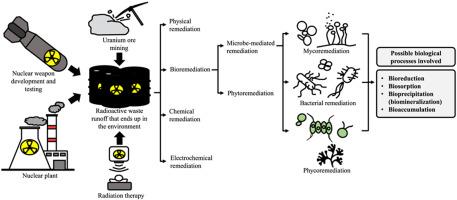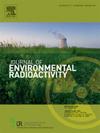Advancements in microbial-mediated radioactive waste bioremediation: A review
IF 1.9
3区 环境科学与生态学
Q3 ENVIRONMENTAL SCIENCES
引用次数: 0
Abstract
The global production of radioactive wastes is expected to increase in the coming years as more countries have resorted to adopting nuclear power to decrease their reliance on fossil-fuel-generated energy. Discoveries of remediation methods that can remove radionuclides from radioactive wastes, including those discharged to the environment, are therefore vital to reduce risks-upon-exposure radionuclides posed to humans and wildlife. Among various remediation approaches available, microbe-mediated radionuclide remediation have limited reviews regarding their advances. This review provides an overview of the sources and existing classification of radioactive wastes, followed by a brief introduction to existing radionuclide remediation (physical, chemical, and electrochemical) approaches. Microbe-mediated radionuclide remediation (bacterial, myco-, and phycoremediation) is then extensively discussed. Bacterial remediation involves biological processes like bioreduction, biosorption, and bioprecipitation. Bioreduction involves the reduction of water-soluble, mobile radionuclides to water-insoluble, immobile lower oxidation states by ferric iron-reducing, sulfate-reducing, and certain extremophilic bacteria, and in situ remediation has become possible by adding electron donors to contaminated waters to enrich indigenous iron- and sulfate-reducing bacteria populations. In biosorption, radionuclides are associated with functional groups on the microbial cell surface, followed by getting reduced to immobilized forms or precipitated intracellularly or extracellularly. Myco- and phycoremediation often involve processes like biosorption and bioaccumulation, where the former is influenced by pH and cell concentration. A Strengths, Weaknesses, Opportunities, and Threats (SWOT) analysis on microbial remediation is also performed. It is suggested that two research directions: genetic engineering of radiation-resistant microorganisms and co-application of microbe-mediated remediation with other remediation methods could potentially result in the discovery of in situ or ex situ microbe-involving radioactive waste remediation applications with high practicability. Finally, a comparison between the strengths and weaknesses of each approach is provided.

微生物介导的放射性废物生物修复的进展:综述。
随着越来越多的国家采用核能来减少对化石燃料能源的依赖,预计未来几年全球放射性废料的产生量将会增加。因此,发现能够清除放射性废料(包括排放到环境中的废料)中放射性核素的修复方法,对于降低放射性核素对人类和野生动物造成的暴露风险至关重要。在现有的各种修复方法中,微生物介导的放射性核素修复方法在进展方面的评论有限。本综述概述了放射性废物的来源和现有分类,然后简要介绍了现有的放射性核素修复(物理、化学和电化学)方法。然后广泛讨论了微生物介导的放射性核素修复(细菌修复、微生物修复和植物修复)。细菌修复涉及生物还原、生物吸附和生物沉淀等生物过程。生物还原包括铁还原菌、硫酸盐还原菌和某些嗜极细菌将水溶性、可移动的放射性核素还原成不溶于水、不移动的低氧化态。在生物吸附过程中,放射性核素与微生物细胞表面的功能基团结合,然后被还原成固定形式,或在细胞内或细胞外沉淀下来。微生物和植物修复通常涉及生物吸附和生物累积等过程,其中前者受 pH 值和细胞浓度的影响。此外,还对微生物修复的优势、劣势、机会和威胁(SWOT)进行了分析。报告提出了两个研究方向:抗辐射微生物的基因工程和微生物介导修复与其他修复方法的共同应用,这两个方向有可能导致发现具有高度实用性的原位或非原位微生物放射性废物修复应用。最后,对每种方法的优缺点进行了比较。
本文章由计算机程序翻译,如有差异,请以英文原文为准。
求助全文
约1分钟内获得全文
求助全文
来源期刊

Journal of environmental radioactivity
环境科学-环境科学
CiteScore
4.70
自引率
13.00%
发文量
209
审稿时长
73 days
期刊介绍:
The Journal of Environmental Radioactivity provides a coherent international forum for publication of original research or review papers on any aspect of the occurrence of radioactivity in natural systems.
Relevant subject areas range from applications of environmental radionuclides as mechanistic or timescale tracers of natural processes to assessments of the radioecological or radiological effects of ambient radioactivity. Papers deal with naturally occurring nuclides or with those created and released by man through nuclear weapons manufacture and testing, energy production, fuel-cycle technology, etc. Reports on radioactivity in the oceans, sediments, rivers, lakes, groundwaters, soils, atmosphere and all divisions of the biosphere are welcomed, but these should not simply be of a monitoring nature unless the data are particularly innovative.
 求助内容:
求助内容: 应助结果提醒方式:
应助结果提醒方式:


